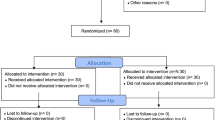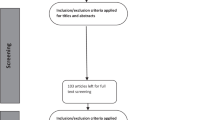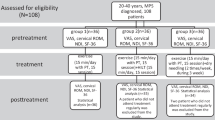Abstract
The aim of this study is to compare the effect of phonophoresis, ultrasound and placebo ultrasound therapies in the treatment of myofascial pain syndrome (MPS). This is a randomized, double-blind placebo controlled study. Sixty patients (48 women, 12 men, mean age 37.9 ± 12.2 years) with MPS were included in this study. Patients were allocated into three groups. Group 1(n = 20) was received diclofenac phonophoresis, group 2(n = 20) was received ultrasound and group 3(n = 20) was received placebo ultrasound therapies over trigger points, 10 min a day for 15 session during 3 weeks (1 MHz-1,5 watt/cm2). Additionally, all patients were given neck exercise program including isotonic, isometric and stretching. Patients were assessed by means of pain, range of motion (ROM) of neck, number of trigger points (NTP), algometric measurement and disability. Pain severity was measured by visual analog scale (VAS) and Likert scale. The neck pain disability index (NPDI) was used for assessing disability. Measurements were taken before and after treatment. After treatment, there were statistically significant improvements in pain severity, NTP, pressure pain threshold (PPT), ROM and NPDI scores both in phonophoresis and in ultrasound therapy groups (P < 0.05). Statistically significant increase in cervical lateral flexion and rotation was observed in the placebo US group. While there was no statistically significant improvement in the cervical flexion–extension joint movement, pain levels, number of trigger points and NPDI score, pressure pain threshold (P > 0.05), also there were no significant differences in all parameters between group 1 and 2 (P = 0.05). Both diclofenac phonophoresis and ultrasound therapy were effective in the treatment of patients with MPS. Phonophoresis was not found to be superior over ultrasound therapy.
Similar content being viewed by others
References
Lavelle ED, Lavelle WL, Smith HS (2007) Myofascial trigger points. Med Clin N Am 91:229–239
Testa M, Barbero M, Gherlone E (2003) Trigger points: update of the clinical aspects. Eur Med Phys 39:37–43
Srbely JZ, Dickey JP (2007) Randomized controlled study of the antinociceptive effect of ultrasound on trigger point sensitivity: novel applications in myofascial therapy? Clin Rehabil 21:411–417
Simons DG (1988) Myofascial pain syndromes: where are we? Where are we going? Arch Phys Med Rehabil 69:207–212
Wals NE, Dumitru D, Schoenfeld LS, DeLisa JA (2005) Treatment of the patient with chronic pain. In: DeLisa JA, Gans B (eds) Physical medicine & rehabilitation principles and practice. Lippincott Williams &Wilkins, Philadelphia, pp 493–529
Machet L, Boucaud A (2002) Phonophoresis: efficiency, mechanisms and skin tolerance. Int J Pharm 243:1–15
Windt D, Heijden G, Berg S, Riet G, Winter A, Bouter L (1999) Ultrasound therapy for musculoskeletal disorders: a systematic review. Pain 81:257–271
Gam AN, Warning S, Larsen LH, Jensen B, Hoydalsmo O, Allon I et al (1998) Treatment of myofascial trigger—points with ultrasound combined with massage and exercise a randomised controlled trial. Pain 77:73–79
Robertson VJ, Baker KG (2001) A review of therapeutic ultrasound: effectiveness studies. Phys Ther 81:1339–1350
Byl NN (1995) The use of ultrasound as an enhancer for transcutaneous drug delivery: phonophoresis. Phys Ther 75:539–553
Simons DG (1990) Muscular pain syndrome. In: Friction JR, Awad EA (eds) Advances in pain research and therapy. Raven Press, New York, pp 1–41
Wolfe F, Smyte HA, Yunus MD, Bennett RM (1990) American College of Rheumatology 1990 criteria for the classification of fibromyalgia. Arthritis Rheum 33:160–172
Bicer A, Yazici A, Camdeviren H, Erdogan C (2004) Assessment of pain and disability in patients with chronic neck pain: reliability and construct validity of the Turkish version of the neck pain and disability scale. Disabil Rehabil 26:959–962
Kozanoglu E, Basaran S, Güzel R, Uysal F (2003) Short term efficacy of ibuprofen phonophoresis versus continuous ultrasound therapy in knee osteoarthritis. Swiss Med Wkly 133:333–338
Hoppenrath T, Ciccone CD (2006) Is there evidence that phonophoresis is more effective than ultrasound in treating pain associated with lateral epicondylitis. Phys Ther 86:136–140
Basford JR (2005) Therapeutic physical agents. In: DeLisa JA, Gans B (eds) Physical medicine & rehabilitation principles and practice. Lippincott Williams &Wilkins, Philadelphia, pp 251–270
Weber DC, Brown AW (2000) Physical agent modalities. In: Braddom RL (ed) Physical medicine & rehabilitation. WB Saunders, Philadelphia, pp 440–458
Klaiman MD, Shrader JA, Danoff JV, Hicks JE, Pesce WJ, Ferland J (1998) Phonophoresis versus ultrasound in the treatment of common musculoskeletal conditions. Med Sci Sports Exerc 30:1349–1355
Shin SM, Choi JK (1997) Effect of indomethacin phonophoresis on the relief of temporomandibular joint pain. Cranio 15:345–348
Hsieh YL (2006) Effects of ultrasound and dicofenac phonophoresis on inflammatory pain relief: suppression of inducible nitric oxide synthase in arthritic rats. Phys Ther 86:39–49
Esenyel M, Caglar N, Aldemir T (2000) Treatment of myofascial pain. Am J Phys Med Rehabil 79:48–52
Cummings M, Baldry P (2007) Regional myofascial pain: diagnosis and management. Best Pract Res Clin Rheumatol 21:367–387
Author information
Authors and Affiliations
Corresponding author
Rights and permissions
About this article
Cite this article
Ay, S., Doğan, Ş.K., Evcik, D. et al. Comparison the efficacy of phonophoresis and ultrasound therapy in myofascial pain syndrome. Rheumatol Int 31, 1203–1208 (2011). https://doi.org/10.1007/s00296-010-1419-0
Received:
Accepted:
Published:
Issue Date:
DOI: https://doi.org/10.1007/s00296-010-1419-0




